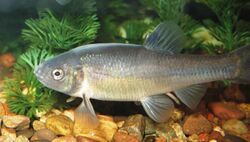Biology:Nuptial tubercles

Nuptial tubercles (also called nuptial efflorescences, breeding tubercles or pearl organs)[1] are dermal structures present in 15 families of fish belonging to 4 orders of Actinopterygii – Salmoniformes, Gonorhynchiformes, Cypriniformes and Perciformes[2] – used in the courtship and reproduction process. They consist of partially or fully keratinised cells that form a perceptible protrusion in certain regions, used to stimulate females during courtship.[3] Their development is stimulated by hormones secreted by the pituitary and adrenal glands, and is induced shortly before the breeding season and discarded after. In some species, at least, there is a correlation between the level of androgens present in the endocrine system and the volume and complexity of tubercle growth.[4][5]
Use and description

Nuptial tubercles are skin nodules made of keratin, the same material as hair, hooves, and fingernails. They normally form on the heads of male fish, often covering the whole of the top part of the snout, but may also occur on fins, or anywhere else on the scaled integumentary system. The actual purpose of nuptial tubercles is not definitely known. There are many theories about their function, which include: use to stimulate females during courtship, in aggressive rituals performed by males during mate selection, or to maintain contact between individuals during reproduction. There is definite proof that they grow mainly on areas with greater mechanical stress,[4] which means that those species that head-butt females to stimulate them to release eggs will have more on the head, whereas those that dig nests in gravel substrates will develop them more on their fins. Tubercles occasionally develop on female fish also, but this is rare, and they are often barely visible to the naked eye.
In addition to the tubercles, cichlid males may also produce Nuchal humps (Koks),[6] where additional fat is laid under the skin over the skull forming a hump on the head.
Nuptial tubercules have been described as a honest signal of the general health of the male bearer. Indeed, research has proven a correlation between tubercle density and parasite resistance,[7] though it is not always a positive correlation.[8]
In species that use lek mating, the females choose the males with the roughest skin, but were not confused by males that had papillomatosis (a skin disease resulting in rough skin).[4]
The presence of nuptial tubercles has been used to distinguish speciation. The genus Leucos was described from similar Rutilus species in Europe as they do not develop them.[9] Similarly, the description of Messinobarbus (now a synonym of Luciobarbus) in 1994 was an attempt to distinguish those species with them from Barbus that do not have them.[10]
List of species
The following species are known to produce nuptial tubercles.
- Common bream, Abramis brama
- Stone-roller, Campostoma anomalum
- Goldfish, Carassius auratus
- Zebrafish, Danio rerio
- Knodus nuptialis[11]
- Fathead minnow, Pimephales promelas
- Common roach, Rutilus rutilus
See also
Nuptial pad - a similar ornament of frogs
References
- ↑ "nuptial tubercle". Academic Dictionaries and Encyclopedias: Dictionary of ichthyology. https://en_ichthyology.en-academic.com/11908/nuptial.
- ↑ Froese, Rainer; Pauly, Daniel, eds. "Glossary Search for nuptial tubercle". https://fishbase.mnhn.fr/glossary/Glossary.php?q=nuptial+tubercle#:~:text=Breeding%20tubercles%20may%20function%20to,in%20sex%20and%20species%20recognition..
- ↑ Wiley, M. L.; Collette, B. B. (1970). "Breeding tubercles and contact organs in fishes: their occurrence, structure, and significance". Bulletin of the American Museum of Natural History 143: 145–216.
- ↑ 4.0 4.1 4.2 Raine Kortet; Jouni Taskinen; Anssi Vainikka; Hannu Ylönen (August 2004). "Breeding Tubercles, Papillomatosis and Dominance Behaviour of Male Roach (Rutilus rutilus) During the Spawning Period". Ethology 110 (8): 591–601. doi:10.1111/j.1439-0310.2004.01002.x. Bibcode: 2004Ethol.110..591K.
- ↑ Poncin, P., Matondo, B.N., Termol, C. et al. Relationships between circulating androgens, aggressive behaviour and breeding tubercles in males of the common bream Abramis brama L. in an aquarium environment. Fish Physiol Biochem 37, 533–542 (2011). https://doi.org/10.1007/s10695-010-9455-y
- ↑ Dual function and associated costs of a highly exaggerated trait in a cichlid fish Sina J. Rometsch, Julián Torres-Dowdall, Gonzalo Machado-Schiaffino, Nidal Karagic, Axel Meyer First published: 23 November 2021 https://doi.org/10.1002/ece3.8383
- ↑ Taskinen, J.; R. Kortet (2002). "Dead and alive parasites: sexual ornaments signal resistance in the male fish, Rutilus rutilus". Evolutionary Ecology Research 4: 919–929. https://www.researchgate.net/publication/228823837.
- ↑ R. Kortet; J. Taskinen (7 May 2004). "Parasitism, condition and number of front head breeding tubercles in roach (Rutilus rutilus L.)". Ecology of Freshwater Fish 13 (2): 119–124. doi:10.1111/j.1600-0633.2004.00039.x. Bibcode: 2004EcoFF..13..119K.
- ↑ Bianco, P.G., Ketmaier, V. (2014). A revision of the Rutilus complex from Mediterranean Europe with description of a new genus, Sarmarutilus, and a new species, Rutilus stoumboudae (Teleostei: Cyprinidae). Zootaxa, 3841 (3): 379–402.
- ↑ Bianco, P.G. (1998). "Diversity of Barbinae fishes in southern Europe with description of a new genus and a new species (Cyprinidae)". Italian Journal of Zoology 65 (1): 125–136. doi:10.1080/11250009809386804.
- ↑ Menezes, N.A., and M.M.F. Marinho (2019). A New Species of Knodus Eigenmann (Characiformes: Characidae: Stevardiinae) with Comments on Nuptial Tubercles and Gill Gland in Characiform Fishes. PLoS ONE 14(7): e0217915. doi:10.1371/journal.pone.0217915
Further reading
- Stephanie C. McMillan, Zhe T. Xu, Jing Zhang, Cathleen Teh, Vladimir Korzh, Vance L. Trudeau, Marie-Andrée Akimenko "Regeneration of breeding tubercles on zebrafish pectoral fins requires androgens and two waves of revascularization" Development (2013) 140 (21): 4323–4334.
https://doi.org/10.1242/dev.095992
Template:Vertebrate-anatomy-stub
This article needs additional or more specific categories. (January 2024) |
 |
